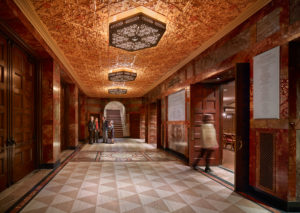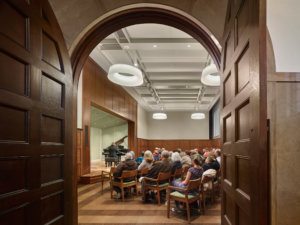Every historic theater needs an update sooner or later. A building that may have once evoked the nostalgia of old Hollywood or the grandeur of the Victorian era will, at some point, show signs of aging, inefficiency, and safety issues.
As lighting designers develop their concept for restoring and renovating a historic theater, several facets inform the design approach: the building’s original je ne sais quoi, its architecture, and the client’s renovation goals. Those goals often include conserving the building’s original details, improving the guest experience, and reducing energy consumption. However, there is another, often unexpected opportunity that makes lighting design key to taking the renovation above and beyond the client’s aspirations.
Modern technology has done more than improve the energy efficiency of lighting; it has also substantially decreased the size of light sources. When undergoing a renovation/restoration project, a historic theater benefits from the diminutive scale of LEDs, allowing them to highlight and accentuate the beauty of its architecture in new, creative ways.
The transformation of Case Western Reserve University’s Maltz Performing Arts Center is a prime example of this opportunity. Led by MGA Partners, the design team adapted a historically landmarked synagogue into a performing arts venue while preserving its architectural character. The new high-color rendering capability and energy efficiency of the lighting system were only the beginning of the splendor that resulted from the update. Thanks to the small size of the LEDs, Al Borden, Emad Hasan, and David Seok were able to seamlessly integrate lighting into window niches high on the auditorium’s walls to accentuate the ceiling with a soft glow and showcase the majesty of the volume. In the prefunction, surface-mounted decorative lighting elements were refurbished, adding a low-profile indirect LED source. Reinstalled to float just below the ceiling plane, they cast a magical light across the terra cotta ceiling system, revealing a layer of warmth and texture. This process of weaving lighting seamlessly into the architecture revealed these and many other layers and details of the building that were previously unnoticed. The project gave the synagogue a second life as a performance space while showcasing it as an architectural gem.
Innovations in lighting present new opportunities to tell a historic theater’s story. Architectural details, unique finishes and other features come to life with the help of new lighting that offers minimal disturbance to the architecture. A renovation to the Civic Theatre of Allentown, led by Mills + Schnoering Architects, emphasized the importance of conserving its original Art Deco details and artwork while improving the poor visual conditions. Jered Widmer and Chris Hallenbeck studied the existing architectural fabric to find ways to discreetly install light sources, improve the overall aesthetic environment, and reveal more of the architecture for guests to enjoy.
Improvement to the Civic Theatre’s ceiling lighting was an important facet of the project. The existing incandescent uplight cove had no optical distribution and rendered the ceiling harshly. Jered and Chris replaced the old fixtures with smaller, more precise LEDs with optics that push light across the ceiling, highlighting its texture and balancing the contrast. Existing harsh and unappealing house lights were replaced with small aperture downlights hidden within the ceiling screens to cast a soft layer of light to the seating below.
Restored murals that once sat in shadows along the back wall of the house were brought to life with discretely placed linear wallwashers. TLP also guided the refurbishment of decorative sconces and exit signs with LED sources. The new architectural house lighting control system, integrated with the theatrical lighting system, has improved the guest experience while preserving the historical architectural fabric of the theater.
As the design team breathes new life into a theater through architectural and technological innovations, lighting can help retell the building’s story, history, and architectural nuances in new and vibrant ways. The result is an evolved space that offers modern amenities and functions while reminiscing on the beauty and nostalgia of yesteryear.












